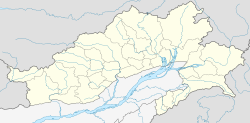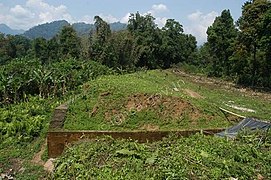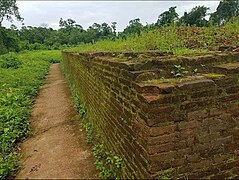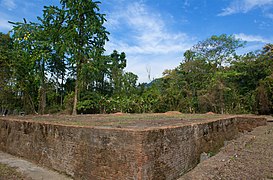Bhismaknagar
 Museum history sign | |
| Alternative name | Sadhayapur |
|---|---|
| Location | Lower Dibang Valley district, Arunachal Pradesh, India |
| Coordinates | 28°02′48.2″N 96°0′20.7″E / 28.046722°N 96.005750°E |
| Type | Settlement |
| Length | 4.5 km |
| Width | 2.5 km |
| History | |
| Material | Bricks, Stone, Soil |
| Founded | 8th century |
| Abandoned | 16th century |
| Part of a series on the |
| History of Assam |
|---|
 |
| Categories |
Bhismaknagar is an archeological site in Indian state of Arunachal Pradesh. It is located near Roing in Lower Dibang Valley district.[1] The remains are generally ascribed to the rule of the Sutiyas a Tibeto-Burmese ethnic group[2] who ruled over the region of Sadiya from 11th to 16th Century CE.[3]
Etymology
[edit]The name Bhismaknagar was first observed in the Assam District Gazetteer of the year 1928[4]—reference to a work by the 16th-century seer Sankardev that was popular in the Sadiya region (which eventually found its way into the later Chutia chronicles.)[note 1]
Historically, the region was known as Sadhayapura (the rulers being Sadhayapur-ishwar) as per copper inscriptions[7] and the fort formed part of the capital region of the Chutia king Laksminarayana,[8] also known as Che-lung in Tai Buranjis (meaning "Great City" in English).
Location
[edit]It is located in Lower Dibang Valley district. The campus of the old city is spread over an area of 2500 acres.
History
[edit]Bhismaknagar is an important ancient archeological site. The site was one of the stronghold of the Chutia Kingdom. The ruins have been dated between the 11th-15th centuries.[9] Bhismaknagar has been identified with Sadhayapuri (or Svadhayapuri), the political centre of the Chutia Kingdom.[10] Based on an inscriptions on brick, it is assumed to have been the capital of Chutia king Lakṣmīnārāyaṇa, of the early 15th century. Paleographical analysis supports this dating.[11]
Architecture
[edit]The fort, with its fortifications and buildings, is built of fired bricks. The fortified city is spread over an area of 10 square km. The wall, spread on the east, west and south directions, is 4.5 meters high and 6 meters wide, made using granite stone (6-9 courses)[12][13][14] and bricks. In the north, the Mishmi hills provided a natural barrier. Although very less excavation has been carried out by the Arunachal government, preliminary excavations have revealed three tanks and two gates in the eastern and western directions.[15]
The Bhismaknagar central complex extended over an area of 1860 square meters and displays three halls, six ingresses and two extension rooms. There is also a 2 meters high stone wall inside the complex. The architecture of the fort displays the medieval culture. While quarrying the fort the enormous pieces of work of art like potteries, terracotta figurines, terracotta plaques and decorative tiles were preserved.[13]
Gallery
[edit]-
ASI Plaque with information on Bhismaknagar.
-
A section of the brick platform of Bhismaknagar.
-
Section of the fortified brick wall leading to the western gateway.
-
A section of the eastern brick gateway of the city.
-
A section of the western gateway with the upper damaged portion of the wall removed.
-
A section of the brick wall leading to the eastern gateway.
-
Another section of the Western wall.
-
The three compartments of the central building.
-
A separate structure inside the fortified walls.
-
Central platform of Bhismaknagar.
-
A brick found in Bhismaknagar Fort with the Chutia king Lakshminarayan's name inscribed in it.
-
Western gateway with the upper damaged portions removed.
-
Potsherds found in Bhismaknagar.
-
A section of the central building of Bhismaknagar.
-
Mud pot with holes.
-
Brick of Bhismaknagar.
-
Section of the western brick wall.
-
A section of western wall in Bhismaknagar
-
Various artifacts found in Bhismaknagar.
-
Bhismaknagar complex
-
A brick platform of Bishmak Nagar temple in Arunachal Pradesh
-
A stack of bricks of Bishmak Nagar ruins.
-
Another view of the platform of the central building.
Notes
[edit]- ^ Among many works of Śankaradeva, the Rukmiṇiharaṇa, the poem of Rukmimi and Krishna, gained considerable popularity in the Sadiya area and influenced its regional identity construction. Rukmiṇī, in this poem, was a daughter of king Bhīṣmaka.[5]The Bhīṣmaka lineage became a part of the new literary tradition of the region and eventually found its way into the later Chutiya chronicles.[6]
- ^ "Bhismaknagar". Government of Arunachal Pradesh. Archived from the original on 11 June 2017.
- ^ The Sutiyas belong to the Bodos, a linguistic group of the Brahmaputra valley, speaking a Tibeto-Burman language and having different cognate groups within them.(Shin 2020, p. 51)
- ^ http://asiguwahaticircle.gov.in/bhismaknagar.html Remains at Bhismaknagar (ASI official website), "The remains are generally ascribed to he rule of the 'Chutias', a Tibeto-Burmese tribe who ruled over the region of Sadiya from 11th to 16th Century CE."
- ^ "Again at Bishemnagar or Bishmuknagar, situated near Chipulin village up the Balijan (Sunpura) river and accessible from mile 27 on the Lohit valley road, is the remains of a large fort and settlement. It is supposed to have been built by Raja Bishmook or Bhikrum, Raja of Kundilpur, father of Rukmini."(C. Allen 1928:19)
- ^ Shin 2020, p. 55.
- ^ Shin 2020, p. 57.
- ^ "Furthermore, it is fairly certain from the dates available in the inscriptions that Nandin and Satyanārāyaṇa ruled Sadhayāpurī in the latter half of the fourteenth century, while Lakṣmīnārāyaṇa belonged to the beginning, and Dharmanārāyaṇa to the middle of the fifteenth century. It is also nearly clear that Sadhayāpurī (or Svadhayāpurī) mentioned in the inscriptions is the same as Sadhiyā or Sadiya of later times." (Shin 2020:52)
- ^ "The ruins of two forts in Lohit district of Arunachal Pradesh are said to be the remains of Bhīṣmaka’s city, viz. Bhismaknagar (sk. Bhīṣmakanagara): one ruin about 16 miles northwest of Sadiya at the foot of the hills between the rivers Dikrang and Dibang is known as the fort of Bhīṣmaka, and the other about 24 miles north of Sadiya between the gorges of those two rivers is believed to be the fort of Śiśupāla. Based on an inscribed brick with the name of Śrī-śrī-Lakṣmīnārāyaṇa, discovered from the ruins of the forts in Bhismaknagar, it is assumed that Chutiya king Lakṣmīnārāyaṇa of the early fifteenth century had his capital in the area. The paleographical analysis of the inscription supports this dating." (Shin 2020:56)
- ^ Tada, Dutta & Deori 2012, p. 8.
- ^ Momin, Mawlong & Qādrī 2006, p. 47.
- ^ Based on an inscribed brick with the name of Śrīśrī-Lakṣmīnārāyaṇa, discovered from the ruins of the forts in Bhismaknagar, it is assumed that Chutiya king Lakṣmīnārāyaṇa of the early fifteenth century had his capital in the area. The paleographical analysis of the inscription supports this dating (Shin 2020, p. 56)
- ^ (Gait 1906:16)
- ^ a b Tada 2011, p. 114.
- ^ Chattopadhyay 1984.
- ^ A. Raikar 1980, p. 19.
References
[edit]- Gait, Edward Albert (1906), A history of Assam, Calcutta, Thacker, Spink & co.
- Shin, Jae-Eun (2020). "Descending from demons, ascending to kshatriyas: Genealogical claims and political process in pre-modern Northeast India, The Chutiyas and the Dimasas". The Indian Economic and Social History Review. 57 (1): 49–75. doi:10.1177/0019464619894134. S2CID 213213265.
- Tada, Tage; Dutta, J. C.; Deori, Nabajit (2012). Archaeological Heritage of Arunachal Pradesh. Government of Arunachal Pradesh, Department of Cultural Affairs, Directorate of Research.
- Momin, Mignonette; Mawlong, Cecile A.; Qādrī, Fuz̤ail Aḥmad (2006). Society and Economy in North-East India. Regency Publications. ISBN 9788189233402.
- Tada, Tage (2011). Archaeological remains of Arunachal Pradesh up to 16th century (Ph.D.). Rajiv Gandhi University. hdl:10603/288770.
- A. Raikar, Yashavant (1980). Archaeology in Arunachal Pradesh. Directorate of Research, Govt. of Arunachal Pradesh.
- Chattopadhyay, Subid (1984). History and archaeology of Arunachal Pradesh (Ph.D.). University of Calcutta. hdl:10603/159414.
- C. Allen, B (1928). Assam district gazetteers. Vol. XI. Baptist Mission Press.

























